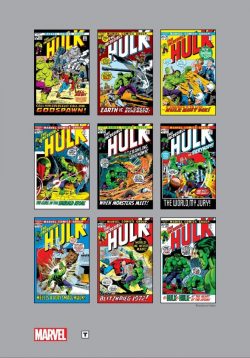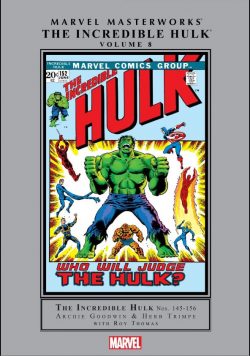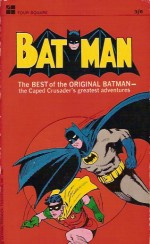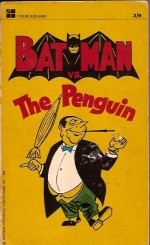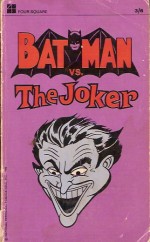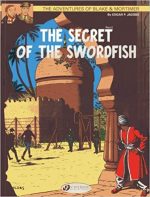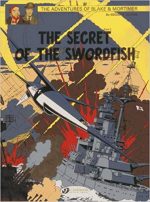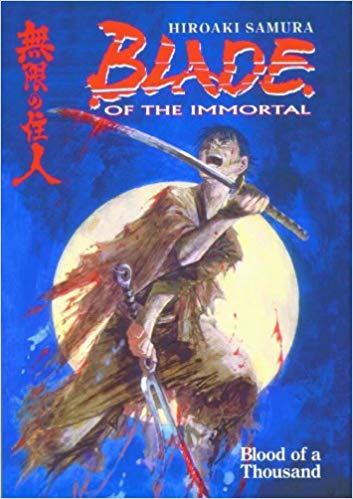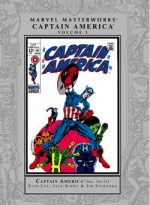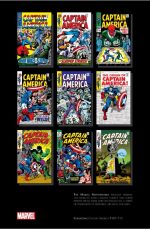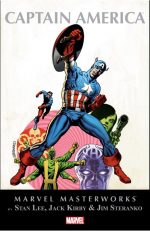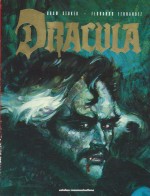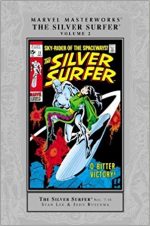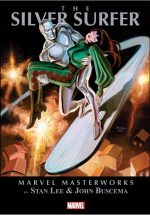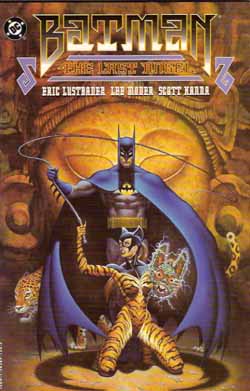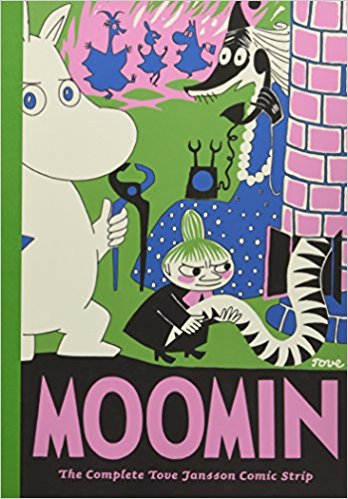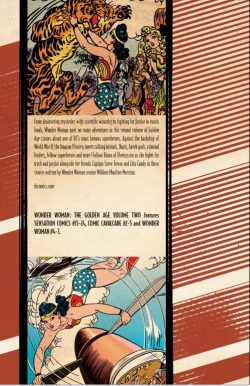
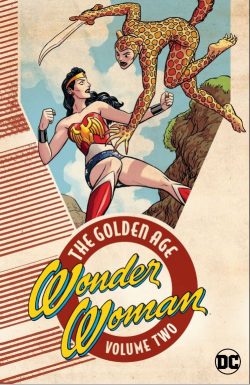
By William Moulton Marston & Harry G. Peter with Frank Godwin, Frank Harry & various (DC Comics)
ISBN: 978-1-4012-8536-4 (TPB)
Wonder Woman was conceived by polygraph pioneer William Moulton Marston and illustrated by Harry G. Peter in an attempt to offer girls a positive and forceful role model. She debuted as a special feature in All Star Comics #8 (December 1941), before springing into her own series and the cover-spot of new anthology title Sensation Comics a month later. An instant hit, the Amazing Amazon quickly won her own eponymous supplemental title in late Spring of that year (cover-dated Summer 1942).
Once upon a time on a hidden island of immortal super-women, American aviator Steve Trevor of US Army Intelligence crashed to Earth. Near death, he was nursed back to health by young and impressionable Princess Diana.
Fearing her growing obsession with the creature from a long-forgotten and madly violent world, her mother Queen Hippolyte revealed the hidden history of the Amazons: how they were seduced and betrayed by men but rescued by the goddess Aphrodite on condition that they isolated themselves from the rest of the world and devoted their eternal lives to becoming ideal, perfect creatures.
However, when goddesses Athena and Aphrodite subsequently instructed Hippolyte to send an Amazon back with the American to fight for global freedom and liberty, Diana overcame all other candidates and became their emissary – Wonder Woman.
On arriving in America, she purchased the identity and credentials of lovelorn Army nurse Diana Prince, elegantly allowing the Amazon to be close to Steve whilst enabling the heartsick medic to join her own fiancé in South America. Soon Diana also gained a position with Army Intelligence as secretary to General Darnell, ensuring she would always be able to watch over her beloved. She little suspected that, although the painfully shallow Steve only had eyes for the dazzling Amazon superwoman, the General had fallen for the mousy but superbly competent Lieutenant Prince…
Using the nom de plume Charles Moulton, Marston (with some help in later years from assistant Joye Murchison) scripted almost all of the Amazing Amazon’s many and fabulous adventures until his death in 1947, whereupon Robert Kanigher took over the writer’s role. Venerable veteran illustrator and co-creator H.G. Peter performed the same feat, limning practically every titanic tale until his own death in 1958. A couple of the very rare exceptions appear in this volume…
Spanning March to December 1943 this superb full-colour deluxe softcover compilation (also available as an eBook edition) collects her exploits from Sensation Comics #15-24, Wonder Woman #4-7 plus her adventures from anthological book of (All) Stars Comics Cavalcade #2-5…
In Sensation #15 ‘Victory at Sea’ pits Diana and Steve against murderous saboteurs set on halting military production and working with shady lawyers, whilst in #16 ‘The Masked Menace’ is one of very few stories not illustrated by H.G. Peter but the work of illustrator and strip cartoonist Frank Godwin, stepping in as the crushing workload of an extra 64-page comicbook every couple of months piled the pressure on WW’s artistic director.
The tale sees steadfast Texan Etta Candy ready to elope with slick and sleazy Euro-trash Prince Goulash, until Diana and Steve crash the wedding party to expose spies infiltrating across the Mexican border and a plot to blow up the invaluable Candy family oil-wells…
The inescapable war-fervour was tinged with incredible fantasy in Wonder Woman #4 which opened with ‘Man-Hating Madness!’, wherein a Chinese refugee from a Japanese torture camp reaches America and draws the Amazon into a terrifying scheme to use biological weapons on the American Home Front.
Cruel and misogynistic ‘Mole Men of the Underworld’ then kidnap collegiate sidekicks the Holliday Girls and Diana and reformed and recuperated former-Nazi genius Baroness Paula von Gunther rescue them, free a race of female slaves and secure America’s deepest border from further attack.
‘The Rubber Barons’ provide a rousing romp wherein greedy corporate profiteers attempt to hold the Government and war effort to ransom with a new manufacturing process in a high-tech tale involving mind-control, gender role-reversal and behaviour modification, as only a trained and passionate psychologist could promote them…
The issue concludes with an untitled saga as Paula, now fully accepted into Amazon society, is attacked by Mavis, one of her erstwhile spy-slaves. The traumatised victim then abducts her ex-mistress’ daughter little Gerta and Wonder Woman, burdened with responsibility, is compelled to hunt her down…
A famed classic from Sensation #17 follows ‘Riddle of the Talking Lion’ (also probably drawn by Godwin) wherein Diana Prince visits an ailing friend and discovers that Sally’s kids have overheard a Zoo lion speaking – and revealing strange secrets…
Although Steve and Diana dismiss the tall tale, things take a peculiar turn when the beast is stolen. The trail leads to Egypt and a plot by ambitious Nazi collaborator Princess Yasmini…
At this time National/DC was in an editorially-independent business relationship with Max Gaines that involved shared and cross promotion and distribution for the comicbooks released by his own outfit All-American Publications.
Although technically competitors if not rivals, the deal included shared logos and advertising and even combining both companies’ top characters in the groundbreaking All Star Comics as the Justice Society of America.
However, by 1942 relations between the companies were breaking down – and would culminate in 1946 with DC buying out Gaines, who used the money to start EC Comics.
All-American thus decided to create its own analogue to mammoth sized anthology World’s Finest, featuring top AA characters. The outsized result was Comics Cavalcade…
Next up following a Frank Harry cover of AA Big Three Flash, Green Lantern and our Princess, is Wonder Woman’s first offering from the second issue of that epic title: ‘Wanted by Hitler, Dead or Alive’ (Godwin art), pitting her against devious gestapo agent Fausta Grables…
Also illustrated by superbly gifted classical artist Frank Godwin, ‘The Secret City of the Incas’ from Sensation #18 sees Diana rescue a lost Inca tribe from a despotic theocracy and ancient greed.
- G. Peter drew the vast entirety of Wonder Woman #5 (June/July 1943), presenting an interlinked epic in the ‘Battle for Womanhood’. Here war-god Mars (who instigated the World War from his HQ on the distant red planet through his earthly pawns Hitler, Mussolini and Hirohito) returns to plague humanity directly. This time he enlists the aid of a brilliant but deformed and demented woman-hating psychologist with psychic powers. Tormented Dr. Psycho uses his talents to marry and dominate a medium named Marva, and employs her abilities to form ectoplasmic bodies as he seeks to enslave every woman on Earth.
Happily, Wonder Woman counters his divinely-sponsored schemes, after which prominent sidekicks ‘Etta Candy and her Holliday Girls’ comedically crush a burglary before ‘Mars Invades the Moon’ resumes the overarching tale as the frustrated war-god is ousted by devious deputy the Duke of Deception.
In attempting to take over the Moon – home of peace-loving goddess Diana – Mars makes the biggest error of his eternal life as the Amazing Amazon spearheads a spectacular rescue mission which results in the invaders’ utter rout.
The issue then concludes with ‘The Return of Dr. Psycho’, who escapes prison and again perpetrates a series of ghastly attacks on America’s security and the freedom of women everywhere… until the Holliday Girls and their demi-divine mentor stepped in…
Sensation #19 (Godwin again) features ‘The Unbound Amazon’ who responds to a little boy’s letter and stumbles onto big trouble in the far north woods. Of course, Diana knows little Bobby (as seen in the Adventure of the Talking Lion), and with Nazi spy Mavis on the loose, isn’t about to take any chances.
This terrific thriller is notable for the revelation that if an Amazon removes her Bracelets of Submission she turns into a raving, uncontrolled engine of sheer destruction…
Issue #20 was by H.G. Peter – who was coming to grips with the increased extra workload of the explosively popular 64-page Wonder Woman series every 3 months – and ‘The Girl with the Gun’ sees Diana Prince investigating sabotage at a munitions factory and the murder of a General at WAACs training base Camp Doe. To the Amazon’s complete surprise, the culprit seems to be Marva Psycho, but there is far more going on than at first appears…
In Comics Cavalcade #3, Diana exposes and destroys ‘The Invisible Invader’ devastating American men and munitions…
Godwin again handled the art for Sensation Comics #21 as Steve and Diana track down insidious traitor “the American Adolf†as he conducts a murderous ‘War Against Society’, whilst Wonder Woman #6 – another all-Peter extravaganza – introduces another macabrely memorable foe in ‘Wonder Woman and the Cheetah’.
Marston’s psychiatric background provided yet another deeply disturbed antagonist in the form of sugar sweet debutante Priscilla Rich who shared her own body with a jealously narcissistic, savage feline counterpart dedicated to murder and robbery. The Cheetah frames the Amazing Amazon and almost destroys Steve, Etta and the Holliday girls before Wonder Woman finally quashes her wild rampages.
It wasn’t for long: the Cheetah immediately returns to mastermind an espionage-for-profit ring in ‘The Adventure of the Beauty Club’, resulting in the Perfect Princess being captured by Japan’s High Command before spectacularly busting loose for a final confrontation in ‘The Conquest of Paradise’. Here the Feline Fury infiltrates the home of the Amazons and almost irretrievably poisons the minds of the super women sequestered there…
By this time Peter was fully adapted to his new schedule and in Sensation Comics #22 takes the psychological dramas to new heights as a cured Priscilla Rich is seemingly attacked by her manifested evil self after the Cheetah steals America’s latest weapon ‘The Secret Submarine’…
In issue #23 the creators tackle school bullying and women in the workplace as production line staff are increasingly stricken by ‘War Laugh Mania’. Only one of the problems is being promulgated by Nazi spies though…
Comics Cavalcade #4 (Fall 1943) sees Wonder Woman and the Holliday Girls capture Nazi superspy Bertha Nagle and return ‘The Purloined Pressure Coordinator’ before a resumption of straight action in Sensation #24 where ‘The Adventure of the Pilotless Plane’ sees Steve abducted by Japanese agents whilst investigating a new gas weapon which prevents US aircraft from flying. The vile villains have nothing that can stop Wonder Woman from smashing them and freeing him, however, and the status quo is fully restored by the time Wonder Woman #7 offers an optimistic view of the future in a fantastic fantasy tale…
‘The Adventure of the Life Vitamin’ depicts America in the year 3000AD: a utopian paradise ruled by a very familiar female President, where a miracle supplement has expanded longevity to such an extent that Steve, Etta and all Diana’s friends were still thriving.
Sadly, some old throwbacks still yearn for the days when women were second-class citizens subservient to males, meaning there is still work for the Amazing Amazon to do…
‘America’s Wonderland of Tomorrow’ continues the wry but wholesome sex war with Steve going undercover with the rebel forces: uncovering a startling threat in ‘The Secret Weapon’ before the focus returns to the present and a far more intimate crisis for wilful child Gerta whose mother Paula is forced to deal with a ‘Demon of the Depths’. But is that the evil octopus at the bottom of the paddling pool or her daughter’s dangerously anti-authoritarian attitudes…?
Closing out this epic compilation is one last tale from Comics Cavalcade (#5 Winter 1943) as the Amazon Avenger investigates the ‘Mystery of the Crimson Flame’ exposing a cruel cult of subjugation and terrorism led by conniving man-hating High Priestess Zara…
Too few people seem able to move beyond the supposed subtexts and incontrovertible imagery of bondage and subjugation in Marston’s tales – and frankly there really are a lot of scenes with girls tied up, chained or about to be whipped (men too) – but I just don’t care what his intentions might have been.
I’m more impressed with the skilful drama and incredible imaginative story-elements that are always wonderfully, intriguingly present: I mean, just where do such concepts as giant battle kangaroo steeds or sentient Christmas trees stem from…?
Exotic, baroque, beguiling and uniquely exciting, these Golden Age adventures of the World’s Most Famous female superhero are timeless and pivotal classics in the development of comics books and still provide lashings of fun and thrills for anyone looking for a great nostalgic read.
© 1943, 2018 DC Comics. All Rights Reserved.

